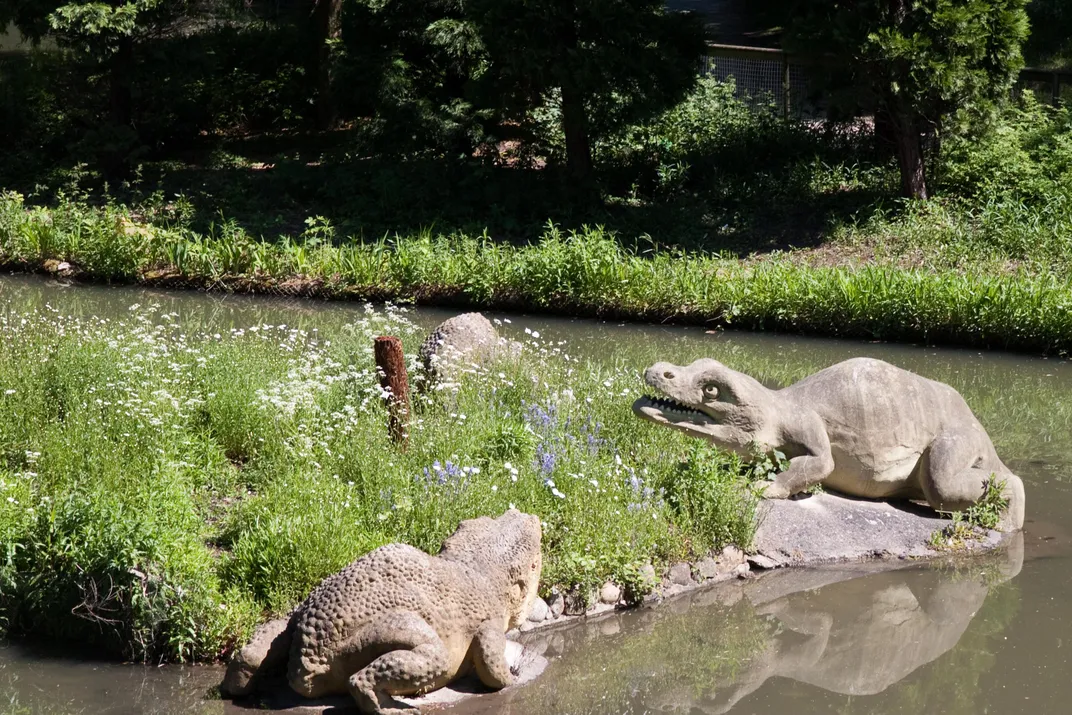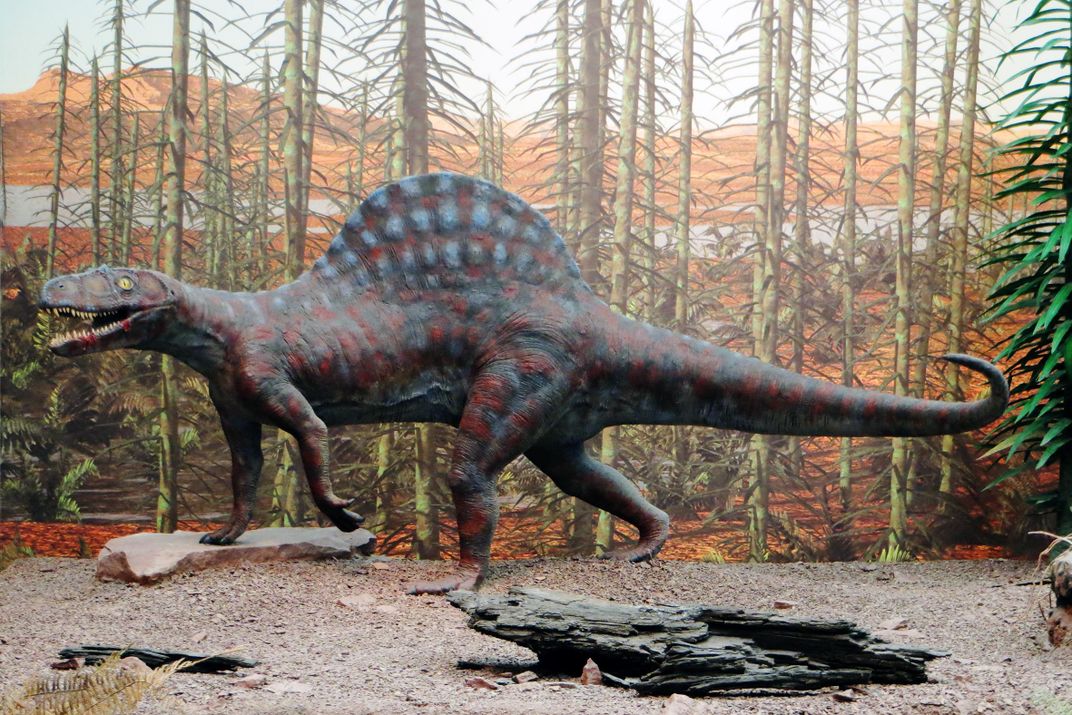The Long, Strange Tale of the Hand Beast Footprints
A Triassic creature left curious tracks in the sandstone; it took decades to unravel the mystery
/https://tf-cmsv2-smithsonianmag-media.s3.amazonaws.com/filer/d3/25/d325b41a-fffb-438c-a627-604d3a951fb9/chirotherium_1rotated.jpg)
In Arthur Conan Doyle’s A Study in Scarlet, the legendary sleuth Sherlock Holmes observes: “There is no branch of detective science which is so important and so much neglected as the art of tracing footsteps. Happily, I have laid great stress upon it, and much practice has made it second nature to me.”
Holmes is able to distinguish the separate tracks of two men from the many footmarks of the constables on the scene. He can calculate when the men arrived, and by the length of their stride, can determine their height. He also determines that one man is fashionably dressed “from the small and elegant impression left by his boots.”
Countless crime scene investigators have used footprints to apprehend culprits, but footprints are also a valuable resource for studying ancient animals. In many rock formations, tracks are the only remaining record that paleontologists can find of animals that lived millions of years ago.
We can identify the creatures who made fossil footprints if the imprints are well-preserved. The details in these will often reveal the configuration of the bones in the hands or feet and even show traces of skin on the palms and soles. From the length of the stride, researchers can also calculate the speed at which the animal moved.
Sometimes, however, the shape of the footprints can be misleading. Take for example, a set of footprints found in 1833, in a small town in Germany. The fossil footprints, discovered during a construction project, confounded the great naturalists of the day. And, therein lies a tale.

Friedrich Sickler, the high-school principal in the town of Hildburghausen, first discovered the fossils. He was building a garden house when he noticed strange imprints on the sandstone slabs that were used for this construction project. The sediment was part of what today is termed the Buntsandstein, meaning “colored sandstone,” which represents the early part of the Triassic Period in much of Europe—about 252 to 248 million years before the present.
Sickler offered rewards for more tracks to the workers in the sandstone quarry and soon a large surface covered with the footprints was exposed. The hind feet imprints looked like large human hands with prominent thumbs. The much smaller front feet left only imprints of the fingers. Unable to identify the maker of these tracks, Sickler published an “open letter” in 1834 describing his discovery to the famous German physician and naturalist Johann Friedrich Blumenbach.
Word of Sickler’s find quickly spread and many naturalists weighed in with interpretations of the track maker. Europe’s natural history museums rushed to acquire track-bearing slabs cut from the quarry’s sandstone surface. Researchers made learned guesses at what sort of creature could have left the tracks. The legendary explorer Alexander von Humboldt believed that they were made by a marsupial. Another naturalist insisted the prints were the tracks of a giant ape and still others offered up animals as varied as giant toads and bears. Finally, the German naturalist Johan Kaup named the unknown creature Chirotherium, which means simply “hand beast” in Greek.
A few years after Sickler’s discovery, Chirotherium tracks were found in Cheshire, England, and later also in France and Spain. Naturalists remained at a loss. The unusual footprints were turning up in other locations but without any known skeletal remains of backboned animals to help identify what could have left them.

In the 1840s, two famous Victorian scientists, Sir Richard Owen and Sir Charles Lyell, developed theories about the animal responsible for the Chirotherium footprints.
From rocks in Warwickshire, Owen identified a few bones similar in age to those from Cheshire as belonging to large amphibian precursors. He named these animals Labyrinthodon because of the labyrinthine folding of the dentine in their teeth. Owen surmised that Labyrinthodon could have made the tracks of Chirotherium. A few years later, Owen began working with the British artist Benjamin Waterhouse Hawkins to build the first life-sized reconstructions of prehistoric animals for the Great Exhibition of 1851 in London. (The models, recently restored, are still on view in a park in Sydenham, London.) The two men envisaged Labyrinthodon as a giant toad-like creature that looked like it had escaped from the nightmarish paintings of Hieronymus Bosch.
Lyell, who is considered the father of modern geology, meanwhile, wondered how the Chirotherium would have ambulated because the “thumbs” of the tracks were pointed to the outside of the foot. Using the Owen-Hawkins model of Labyrinthodon, Lyell surmised that the animal must have walked with its feet crossed! Other researchers found Lyell’s reconstruction implausible, but they could do no better.

Little changed until 1925. That’s when a German paleontologist named Wolfgang Soergel decided to review all available specimens of Chirotherium held in German collections.
Looking at the feet of many living reptiles, he realized that the “thumb” had been misidentified because previous researchers had been so heavily influenced by its similarity to a human thumb. It was, in fact, Soergel pointed out, the fifth toe sticking out from a five-toed hind foot. Measuring the trackways, Soergel, then, reconstructed the limb posture and proportions of the Chirotherium track-maker. In Soergel’s model, the creature would have had strong hind legs and short forelegs, both of which were held much more upright than in living reptiles. The hind feet left large impressions whereas the front feet barely touched the ground. Much like our fingers and toes, well-preserved footprints had distinct crease lines, which allowed Soergel to reconstruct the arrangement of bones in the digits.
But the question still remained: what animal left the Chirotherium footprints?
After an extensive search, Soergel noted that a two-foot-long reptile named Euparkeria roaming South Africa early in the Triassic also had a foot with its fifth toe sticking out to the side. Euparkeria is an ancient precursor of both crocodilians and dinosaurs. Although the reptile that made the Chirotherium tracks was quite a bit larger than little Euparkeria, Soergel inferred that the Chirotherium track-maker was probably related to the South African reptile.
Enter the famous German paleontologist Friedrich von Huene, who in the late 1920s was conducting fieldwork in the Brazilian state of Rio Grande do Sul. A German doctor had sent him crates of unusual bones found there and dating from the Triassic. While in Brazil, Huene became acquainted with a local resident named Vincentino Presto, who knew of a promising deposit of such bones. In 1942, Huene recovered the remains of a large predatory reptile that he christened in honor of Presto, Prestosuchus. This creature attained a length of at least 20 feet and is distantly related to crocodilians.
/https://tf-cmsv2-smithsonianmag-media.s3.amazonaws.com/filer/d4/46/d446d55f-adf3-4a44-ae3f-264d97a315e0/chirotherium_4.jpg)
When Huene reassembled its foot bones he noted a striking resemblance to the foot skeleton that Soergel had reconstructed for the maker of Chirotherium. Huene had come across a major clue about the track-maker. The Chirotherium tracks were probably left by a reptile related to Prestosuchus.
However, at that time, nothing like Prestosuchus had ever been recognized in Europe and other scientists remained unconvinced by Huene’s interpretation.
It was decades later, in 1965 that another major clue emerged, when the French paleontologist Bernard Krebs described the nearly complete skeleton of a ten-foot-long crocodile relative found in Triassic rocks of the Ticino region in Switzerland. Krebs named his creature Ticinosuchus, Latin for “crocodile from the Ticino,” noting that its feet were near-perfect matches to the Chirotherium footprints and its body form closely matched Soergel’s reconstruction. Furthermore, the rocks containing the remains of Ticinosuchus were the same geological age as those with Chirotherium. It was a promising connection.
Meanwhile in 2004, the town of Hildburghausen, looking for its rightful place in history, dedicated a monument to the decades-long long search for the track-maker. It featured the reconstructed original sandstone surface with the Chirotherium tracks but the bronze reconstruction of a crocodile-like reptile was still not quite accurate.

There was one last chapter in this long saga. It involved another reptile—Ctenosauriscus, which is Greek for “comb reptile,” and was from the Buntsandstein of Germany. Very tall spines on its backbone probably supported a sail along the back of the animal. The 2005 publication of a skeleton of the closely related Arizonasaurus in the Moenkopi Formation of Arizona established that the German Ctenosauriscus belonged to the same group of crocodile-like reptiles as Prestosuchus and Ticinosuchus. The Moenkopi Formation is nearly the same geological age as the German Buntsandstein and has also yielded many footprints of Chirotherium.
Now at long last, the Holmesian quest for the maker of the Chirotherium footprints has come to an end. It was crocodile precursors like Arizonasaurus, Ctenosauriscus, Prestosuchus and Ticinosuchus, that had left these prints.
Tracks that resemble those of Chirotherium have now been found on most continents. Some possibly represent precursors of dinosaurs. Many other kinds of fossil footprints have been found, hinting at the existence of as-yet-unknown animals awaiting future discovery. As Sherlock Holmes would have said: “The game is afoot.”
/https://tf-cmsv2-smithsonianmag-media.s3.amazonaws.com/accounts/headshot/HansDS2018.jpg)
/https://tf-cmsv2-smithsonianmag-media.s3.amazonaws.com/accounts/headshot/HansDS2018.jpg)